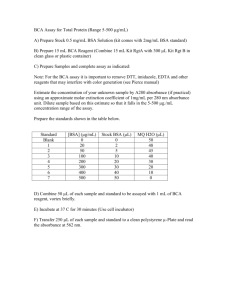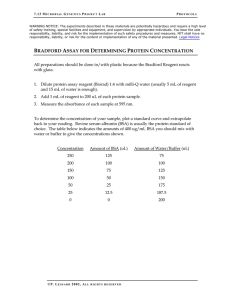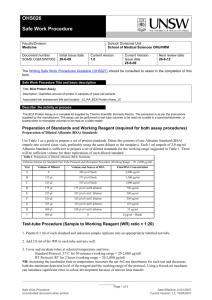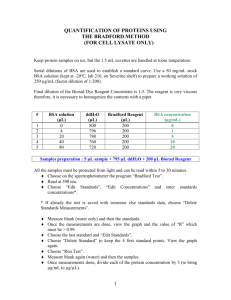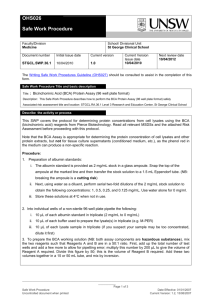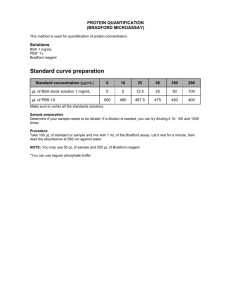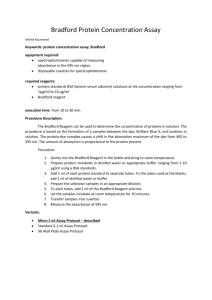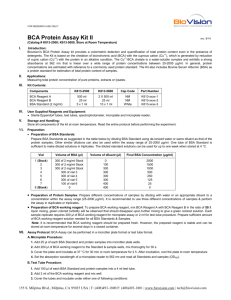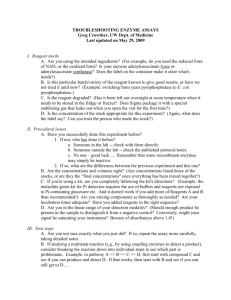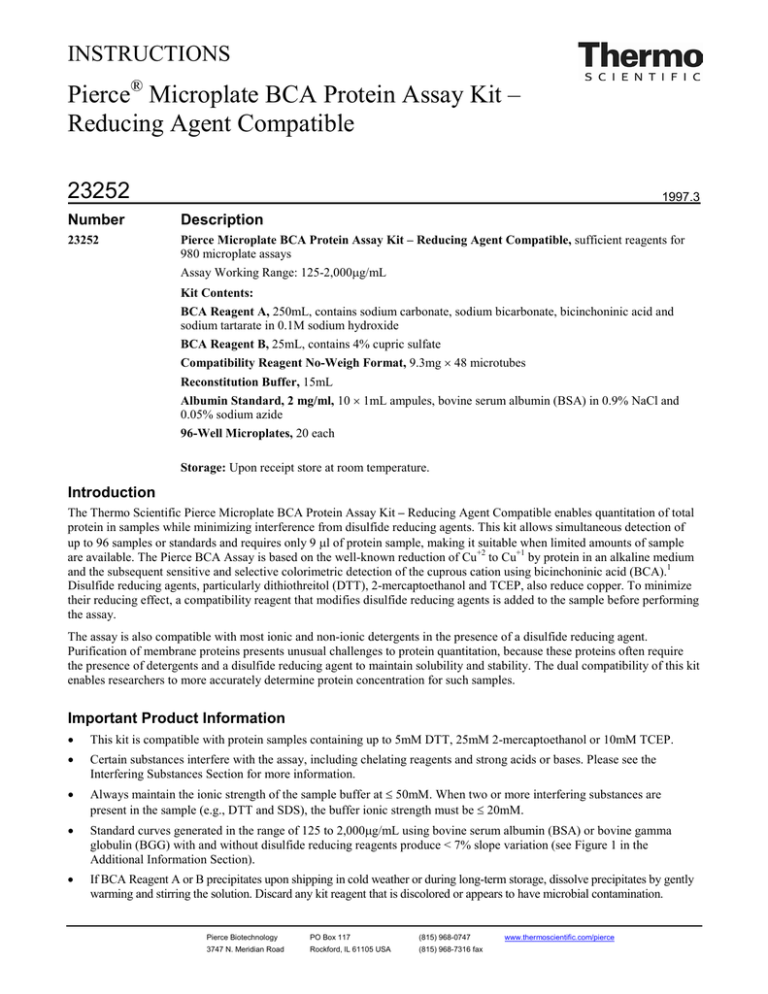
INSTRUCTIONS
Pierce® Microplate BCA Protein Assay Kit –
Reducing Agent Compatible
23252
1997.3
Number
Description
23252
Pierce Microplate BCA Protein Assay Kit – Reducing Agent Compatible, sufficient reagents for
980 microplate assays
Assay Working Range: 125-2,000µg/mL
Kit Contents:
BCA Reagent A, 250mL, contains sodium carbonate, sodium bicarbonate, bicinchoninic acid and
sodium tartarate in 0.1M sodium hydroxide
BCA Reagent B, 25mL, contains 4% cupric sulfate
Compatibility Reagent No-Weigh Format, 9.3mg × 48 microtubes
Reconstitution Buffer, 15mL
Albumin Standard, 2 mg/ml, 10 × 1mL ampules, bovine serum albumin (BSA) in 0.9% NaCl and
0.05% sodium azide
96-Well Microplates, 20 each
Storage: Upon receipt store at room temperature.
Introduction
The Thermo Scientific Pierce Microplate BCA Protein Assay Kit – Reducing Agent Compatible enables quantitation of total
protein in samples while minimizing interference from disulfide reducing agents. This kit allows simultaneous detection of
up to 96 samples or standards and requires only 9 µl of protein sample, making it suitable when limited amounts of sample
are available. The Pierce BCA Assay is based on the well-known reduction of Cu+2 to Cu+1 by protein in an alkaline medium
and the subsequent sensitive and selective colorimetric detection of the cuprous cation using bicinchoninic acid (BCA).1
Disulfide reducing agents, particularly dithiothreitol (DTT), 2-mercaptoethanol and TCEP, also reduce copper. To minimize
their reducing effect, a compatibility reagent that modifies disulfide reducing agents is added to the sample before performing
the assay.
The assay is also compatible with most ionic and non-ionic detergents in the presence of a disulfide reducing agent.
Purification of membrane proteins presents unusual challenges to protein quantitation, because these proteins often require
the presence of detergents and a disulfide reducing agent to maintain solubility and stability. The dual compatibility of this kit
enables researchers to more accurately determine protein concentration for such samples.
Important Product Information
•
This kit is compatible with protein samples containing up to 5mM DTT, 25mM 2-mercaptoethanol or 10mM TCEP.
•
Certain substances interfere with the assay, including chelating reagents and strong acids or bases. Please see the
Interfering Substances Section for more information.
•
Always maintain the ionic strength of the sample buffer at ≤ 50mM. When two or more interfering substances are
present in the sample (e.g., DTT and SDS), the buffer ionic strength must be ≤ 20mM.
•
Standard curves generated in the range of 125 to 2,000µg/mL using bovine serum albumin (BSA) or bovine gamma
globulin (BGG) with and without disulfide reducing reagents produce < 7% slope variation (see Figure 1 in the
Additional Information Section).
•
If BCA Reagent A or B precipitates upon shipping in cold weather or during long-term storage, dissolve precipitates by gently
warming and stirring the solution. Discard any kit reagent that is discolored or appears to have microbial contamination.
Pierce Biotechnology
PO Box 117
(815) 968-0747
3747 N. Meridian Road
Rockford, lL 61105 USA
(815) 968-7316 fax
www.thermoscientific.com/pierce
Additional Materials Required
•
Pipettors and disposable pipette tips
•
An incubator set at 37ºC
Procedure for the Pierce Microplate BCA Protein Assay Kit–Reducing Agent Compatible
A. Control and Standard Preparation
The best method for overcoming the reducing agent effects is to add the same type and amount of reducing agent to each
serially diluted protein standard as present in the samples, but this method is laborious and typically yields < 7% error
compared to standards prepared without added reducing agent. The procedure described in these instructions uses a simpler
method involving two no-protein controls. These controls allow determination of the background absorbance of the standard
and sample. The Standard Control contains no reducing agent, and the Sample Control contains reducing agent.
•
Standard Control: This control does not contain protein. Prepare 200µL of the same buffer as the unknown sample(s)
without reducing agent.
•
Sample Control: This control does not contain protein. Prepare 200µL of the same buffer as the unknown sample with
reducing agent at the same concentration as the sample.
•
Protein Standards: Dilute the contents of one Albumin Standard (BSA) ampule into several microcentrifuge tubes,
preferably using the same buffer as the sample without the reducing agent. Use the following table as a guide to prepare
a set of standards (assay range = 125-2,000µg/mL).
Vial
A
B
C
D
E
F
G
Diluent Volume
(µL)
0
66
100
100
100
100
100
BSA Source and
Volume (µL)
200 of stock
200 of stock
100 of vial A
100 of vial B
100 of vial C
100 of vial E
100 of vial F
Concentration
(µg/mL)
2,000
1,500
1,000
750
500
250
125
Note: Do not discard any unused, undiluted BSA standard (2mg/mL). Store the BSA standard in a microcentrifuge tube
at 4°C for future assays.
B. Reagent Preparation
Working
Reconstitution Buffer
Dilute the Reconstitution Buffer 1:1 with ultrapure water; however, do not dilute the Reconstitution
Buffer if the protein sample has a pH < 6, or if it contains EDTA or imidazole.
Compatibility
Reagent Solution
Puncture the foil covering on the Compatibility Reagent tube with an empty pipette tip. Add 100µL of
Working Reconstitution Buffer into the tube and dissolve by stirring at the bottom of the tube and
pipetting up and down 15-20 times. Store this solution for up to 8 hours at 4°C protected from light.
Used microtubes may be cut and discarded from the unused microtubes. Return the unused microtubes
to pouch containing the desiccant pack.
Note: For each sample, 4µL of Compatibility Reagent Solution is required.
BCA Working
Reagent (WR)
Use the following formula to determine the total volume of WR required: (# controls + # standards
+ # unknowns) × (# replicates) × (volume of WR per sample) = total volume WR required.
Example: For three unknowns and two replicates of each sample:
(2 controls + 7 standards + 3 unknowns) × (2 replicates) × (0.26 ml) = 6.24mL WR required.
To prepare the WR, mix 50 parts BCA Reagent A with 1 part of BCA Reagent B (50:1, Reagent A:B)
Note: When Reagent B is added to Reagent A, the solution appears turbid but yields a clear, green
WR upon mixing.
Pierce Biotechnology
PO Box 117
(815) 968-0747
3747 N. Meridian Road
Rockford, lL 61105 USA
(815) 968-7316 fax
2
www.thermoscientific.com/pierce
C. Assay Protocol
•
Precision pipetting is essential. For best results use 1-10µL pipettes. Completely evacuate the tip of any fluid. Small
errors when pipetting account for large errors when measuring the absorbance.
•
Add samples directly to the center of the well and avoid touching the sides of the well.
•
The same tip may be used within the same group of samples. Use different tip for each sample when adding the
Compatibility Reagent Solution.
1.
If the protein sample has a pH < 5, dilute the sample 1:1 with Reconstitution Buffer.
2.
Pipette 9µL of each replicate of Standard Control, Sample Control, standard and unknown sample to the center of the
microplate well.
3.
Add 4µL of Compatibility Reagent Solution to the sample in each well.
4.
Cover plate and mix on a plate shaker at medium speed for one minute. Incubate plate at 37°C for 15 minutes.
5.
Add 260µL of the WR to each well. Cover plate and mix on a plate shaker for one minute. If the samples contain
detergents, cover the plate after mixing. Incubate plate at 37°C for 30 minutes.
6.
Cool plate at room temperature (RT) for 5 minutes.
7.
Use the Standard Control as the blank. Measure the absorbance of the standards, unknown samples, and Sample Controls
at 562nm on a plate reader.
Note: Because the BCA Assay does not reach a true end point, color development will continue even after cooling to
RT. The absorbance increases at a rate of ~0.25% per minute at RT.
8.
Subtract the average 562nm absorbance value of the Sample Control replicates from the 562nm absorbance value of all
unknown sample replicates.
9.
Prepare a standard curve by plotting the average blank-corrected 562nm value for each BSA standard vs. its
concentration (µg/mL). Use the standard curve to determine the protein concentration of each unknown sample.
Note: If using curve-fitting algorithms associated with a microplate reader, a four-parameter (quadratic) curve produces
more accurate results than a purely linear fit.
Troubleshooting
Problem
No color in any wells
Blank absorbance is OK, but
standards and samples have less
color than expected
Color of samples including
blank appear darker than
expected
Possible Cause
Sample contains a copper-chelating
agent at an incompatible
concentration (see Table 1)
Strong acid or alkaline buffer altered
the Working Reagent pH
Solution
Dilute, dialyze or desalt the sample
Increase copper concentration in the Working
Reagent (e.g., use 50:2, Reagent A:B)
Dilute, dialyze or desalt the sample
Sample contains a reducing agent at
concentrations above the indicated
compatible level
Sample contains biogenic amines
(catecholamines)
Sample contains lipids or
lipoproteins
Dilute sample
Dilute, dialyze or desalt the sample
Add 2% SDS to the sample to eliminate
interference form lipids2
Pierce Biotechnology
PO Box 117
(815) 968-0747
3747 N. Meridian Road
Rockford, lL 61105 USA
(815) 968-7316 fax
3
www.thermoscientific.com/pierce
Interfering Substances
Certain substances interfere with the reducing agent-compatible BCA assay, including those with reducing potential,
chelating agents and strong acids or bases. The following substances interfere even at low concentrations: ascorbic acid,
catecholamines, creatinine, impure glycerol, hydrogen peroxide, hydrazides, iron, certain lipids, melibiose, phenol red,
impure sucrose, tryptophan, tyrosine and uric acid.
Other substances interfere to a lesser extent, and they have only minor (tolerable) effects below a certain concentration in the
original sample. Maximum compatible concentrations for many substances are listed in Table 1. The listed concentrations are
compatible with 5mM DTT, 25mM 2-mercaptoethanol or 10mM TCEP after modification with the Compatibility Reagent.
Substances were considered compatible if the error in concentration estimation caused by the presence of the substance and
the reducing agent was ≤ 10%. Blank-corrected 562nm absorbance values for 1,000µg/mL BSA and the Compatibility
Reagent-modified substance were compared to the net 562nm values of the same standard prepared in water.
Table 1. Compatible substance concentrations for the Pierce Microplate BCA Protein Assay Kit − Reducing
Agent Compatible.
Detergents*
®
Buffers/Salts
Tris
35mM
HEPES, pH 7.5
200mM
MES, pH 6.1
100mM
30mM
Imidazole, pH 7.0
Guanidine•HCl
1.5M
Urea
3M
Sucrose
40%
10%
2%
7%
10%
5%
7%
2%
Tween -20
Triton® X-114
Triton X-100
CHAPS
SDS
Octyl β-thioglucopyranoside
Zwittergent® 3-14
Chelators
EDTA
5mM
EGTA
5mM
Sodium citrate 50mM
Other
L-cysteine
2.5mM
Glutathione‡
10mM
*
Detergents were tested using high-purity Surfact-Amps® Products, which have low-peroxide content.
Reduced glutathione
‡
Additional Information
5mM DTT
1.2
Net Absorbance at 562 nm
Net Absorbance at 562 nm
Standard curves generated ranging from 125 to 2,000µg/mL using bovine serum albumin (BSA) with and without disulfide
reducing reagents produce < 7% slope variation (Figure 1).
1
0.8
0.6
0.4
BSA-DTT
0.2
BSA+DTT
0
0
500
1,000
1,500
2,000
25mM 2-Mercaptoethanol
1.2
1
0.8
0.6
0.4
BSA-2-ME
0.2
BSA+2-ME
0
0
500
1,500
2,000
BSA (µg/mL)
BSA (µg/mL)
Net Absorbance at 562 nm
1,000
1.2
10mM TCEP
1
0.8
0.6
0.4
BSA-TCEP
0.2
BSA+TCEP
0
0
500
1,000
1,500
2,000
BSA (µg/ml)
Figure 1. Standard curves generated using BSA with Compatibility Reagent in the presence and absence of 5mM DTT,
25mM 2-mercaptoethanol and 10mM TCEP. Standard stock solutions were prepared in 0.9% NaCl, 0.05% sodium azide.
Pierce Biotechnology
PO Box 117
(815) 968-0747
3747 N. Meridian Road
Rockford, lL 61105 USA
(815) 968-7316 fax
4
www.thermoscientific.com/pierce
Related Thermo Scientific Products
15045
96-Well Microplates for Pierce BCA Reducing Agent Compatible Kit, 5/pkg.
23209
Albumin Standard Ampules, 2 mg/ml, 10 × 1mL ampules
23208
Pre-Diluted Protein Assay Standards: BSA Set, 7 × 3.5mL ranging from 125 to 2,000µg/mL
23212
23213
Bovine Gamma Globulin Standard, 2 mg/ml, 10 × 1mL ampules
Pre-Diluted Protein Assay Standards, Bovine Gamma Globulin Fraction II (BGG) Set, 7 × 3.5mL
ranging from 125 to 2,000µg/mL
23221
BCA Reagent A, 1,000mL
23223
BCA Reagent A, 250mL
23224
BCA Reagent B, 25mL
23250
Pierce BCA Protein Assay Kit−Reducing Agent Compatible, working range is 125-2,000µg/mL
23235
23236
Pierce Micro BCA Protein Assay Kit, working range of 0.5-20µg/mL
Pierce Coomassie Plus (Bradford) Assay Kit, working range is 1-1,500µg/mL
References
1.
2.
Smith, P.K., et al. (1985). Measurement of protein using bicinchoninic acid. Anal. Biochem. 150(1):76-85.
Kessler, R. and Fanestil, D. (1986). Interference by lipids in the determination of protein using bicinchoninic acid. Anal. Biochem. 159(1):138-42.
This product (“Product”) is warranted to operate or perform substantially in conformance with published Product specifications in effect at the time of sale,
as set forth in the Product documentation, specifications and/or accompanying package inserts (“Documentation”) and to be free from defects in material and
workmanship. Unless otherwise expressly authorized in writing, Products are supplied for research use only. No claim of suitability for use in applications
regulated by FDA is made. The warranty provided herein is valid only when used by properly trained individuals. Unless otherwise stated in the
Documentation, this warranty is limited to one year from date of shipment when the Product is subjected to normal, proper and intended usage. This
warranty does not extend to anyone other than the original purchaser of the Product (“Buyer”).
No other warranties, express or implied, are granted, including without limitation, implied warranties of merchantability, fitness for any particular
purpose, or non infringement. Buyer’s exclusive remedy for non-conforming Products during the warranty period is limited to replacement of or
refund for the non-conforming Product(s).
There is no obligation to replace Products as the result of (i) accident, disaster or event of force majeure, (ii) misuse, fault or negligence of or by Buyer, (iii)
use of the Products in a manner for which they were not designed, or (iv) improper storage and handling of the Products.
Current product instructions are available at www.thermoscientific.com/pierce. For a faxed copy, call 800-874-3723 or contact your local distributor.
© 2011 Thermo Fisher Scientific Inc. All rights reserved. Unless otherwise indicated, all trademarks are property of Thermo Fisher Scientific Inc. and its
subsidiaries. Printed in the USA.
Pierce Biotechnology
PO Box 117
(815) 968-0747
3747 N. Meridian Road
Rockford, lL 61105 USA
(815) 968-7316 fax
5
www.thermoscientific.com/pierce

